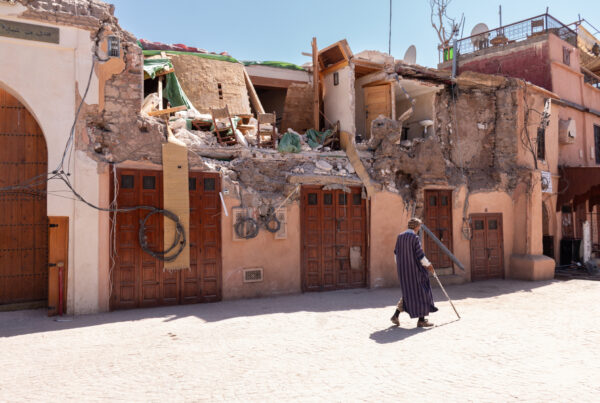
This blog was co-authored by Sasha Chanoff, Founder/CEO of RefugePoint, and Maggi Alexander, TPI Senior Partner and Director of TPI’s Center for Global Philanthropy.
Mangok Bol was only ten years old in 1987 when militias attacked his South Sudan village, separated him from his parents, and forced him to flee on foot with some 20,000 other orphaned children to Kenya’s Kakuma Refugee Camp. Mangok, one of the survivors known as the “Lost Boys of Sudan,” eventually resettled to the US and was welcomed to New England, where he grew up, went to college and graduate school, and became a US citizen. Ten years ago, tragedy struck again. Mangok’s brother and his wife were murdered, and four of their seven young children were kidnapped. As his family’s sole adult male, Mangok swore to find them all and bring them to the US to raise as his own. Incredibly, four children so far have joined him, thanks to Mangok’s tireless efforts and community support as he navigated the pathways to legal immigration available to them. (You can watch the reunion here.)
The world needs more solutions – durable solutions – to the international refugee crisis. The Bol family, like others across Africa, Europe, Latin America, the Middle East, South Asia, and elsewhere, are among the 120 million people forcibly displaced by violence, human rights abuses, and climate change, who flee within their own countries or across borders. Many can never return home.
There is an urgent need, and unique opportunity today, for funders to support new and better legal migration pathways so refugees can rebuild their lives in safety.
Five Legal Pathways Funders Need to Know About
Legal pathways for those fleeing home are tightly controlled, with specific criteria for the refugees who can participate as well as guidelines for their sponsors. Here is a look at five pathways where funders often focus.
1. Refugee Resettlement Programs: Mangok is reuniting with his family thanks to the US Refugee Admissions Program (USRAP) – codified by the 1980 Refugee Act to bring refugees from around the world to the US where they have a pathway to citizenship. The program includes strict vetting of all refugees before they arrive. Some 30 countries have similar refugee resettlement programs to address humanitarian refugee cases.
- Nonprofit organizations play central roles in helping to advance these efforts. Overseas, some of the key organizations identifying refugees for these programs include the UN Refugee Agency, which largely oversees and orchestrates this work in collaboration with governments, RefugePoint, the International Catholic Migration Commission, HIAS, and the International Refugee Assistance Project.
2. Private Sponsorship: A new dimension of the US program is a private sponsorship effort called Welcome Corps, which enables people to form groups and sponsor refugees from abroad to come to America. Groups must raise $2,425 per refugee, arrange housing, pick newcomers up at the airport, help them navigate their new communities, and enroll kids in school among other responsibilities. The US has also created pathways for Ukrainians, and Cubans, Haitians, Nicaraguans, and Venezuelans (known as the CHNV program) that puts the responsibility of housing, finances, and other support on the sponsors. Many other countries are building sponsorship programs as well to take advantage of the spirit of welcome that is prevalent among communities globally.
- The Community Sponsorship Hub leads a coalition of organizations, including CWS (Church World Service), Integrated Refugee & Immigrant Services (IRIS), HIAS, International Rescue Committee, Welcome.US, Welcome NST, React DC, and others, that is building private sponsorship efforts in the US in coordination with the State Department. The Global Refugee Sponsorship Initiative is advancing private sponsorship pathways in countries across the world.
3. Family Reunification: There is an increasing amount of family separation in the vast landscape of forced displacement, and what’s particularly distressing is the growing number of children orphaned or separated from parents. Many countries have enshrined the right of family reunification into their laws, but those who are displaced often need support to realize this right and reunite. A new coalition called the Global Family Reunification Network is bringing together countries, civil society, UN Agencies, and others in a pledge to reunite one million families in the next five years and build better global systems to do so.
4. Refugee Labor Mobility: Labor mobility pathways provide an additional way, beyond resettlement, for displaced people to find durable solutions. These programs recognize refugees’ skills, experience, and talent, while also giving companies in countries experiencing labor shortages the ability to recruit more people with sought-after professional experience, such as health care workers, programmers, teachers, engineers, service industry professionals, and others.
- A new fund to advance labor pathways globally is garnering interest, as well as a new Refugee Talent Catalog, led by Talent Beyond Boundaries, which gives employers the opportunity to search for the talent they need. The Global Task Force on Refugee Labour Mobility is a multi-sectoral and multi-stakeholder initiative whose mission is to increase refugee access to third-country solutions via labor pathways, through global dialogue, and technical advice.
5. Education Pathways: While gaps in secondary education are perhaps the most glaring in refugee settings, those who do make it through high school regularly aspire to further studies. Numerous unique opportunities exist for refugees to access scholarships, and a coalition has come together to advance such opportunities in a more systematic way in the US.
- Welcome Corps on Campus is a coalition consisting of WUSC (World University Service of Canada), the Presidents’ Alliance on Higher Education and Immigration, ECAR (Every Campus a Refuge), NASH Refugee Resettlement Initiative, and the Community Sponsorship Hub.
A Unique Role for Funders
Funders have multiple options to support legal pathways for refugees in the US as well as globally. Private funding has often been a catalyst for these efforts. While migration pathways are created by governments, the UN and nonprofit organizations involved are indispensable partners, often bringing their own vision, creativity, and resources to the table. Many of the organizations listed here, as well as the UN’s International Organization for Migration (IOM) and Pathways International, among others, play roles in building multiple pathways.
Why does all this matter? More solutions are urgently needed for the growing number of refugees who can’t return home. In addition to the clear and growing humanitarian need, refugees are active in and often reinvigorate their communities. In fact, numerous studies find that refugees contribute billions more in government revenue than they cost in services used. Individual stories of success and of dedication to family and community, such as Mangok’s reunion with his niece and nephews, show us what is possible and what the world can look like as we move into the future. Supporting legal pathways for those forcibly displaced is not only a deeply humanitarian effort but also work that can create real and positive change in the neighborhoods in which we all live and work, giving funders a true legacy of which to be proud.
—
If you are a funder interested in learning more or getting involved, please reach out to Maggi Alexander, TPI Senior Partner and Director of TPI’s Center for Global Philanthropy.
Photo by Naeblys via iStock


